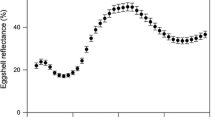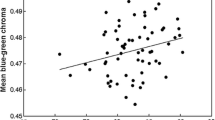Abstract
It has been proposed that blue colouration in eggs has evolved as a signal of female quality that males can use to modulate their parental investment. This hypothesis is based in the antioxidant properties of biliverdin whose costly deposition in the eggshell is expected to signal female antioxidant capacity and egg quality. Since maternally derived androgens are costly to produce and may adaptively affect offspring phenotype, high-quality females may benefit by signalling their androgen investment through egg colouration. Our aim was to investigate whether egg colour variation in the spotless starling reflected the amount of pigments on the eggshell and whether egg pigmentation was related to female and egg quality. Chromatography analyses revealed that spotless starling eggshells contained two different pigments: biliverdin and protoporphyrin IX with no correlation between them. Biliverdin contents correlated positively with egg colouration indicating that darker eggs with a higher peak in the blue–green segment of the spectrum contained higher amounts of biliverdin. Eggs containing more biliverdin were laid by high-quality females and contained higher yolk testosterone levels. However, despite the strong correlation between biliverdin and colorimetric variables, egg colouration did not reflect accurately female and egg quality. Our results provide evidence that eggshell pigmentation in the spotless starling is related to female and egg quality as shown by the yolk testosterone levels. However, the lack of relation between egg colour and female condition and egg quality do not provide evidence to support the signalling function of egg colouration.



Similar content being viewed by others
References
Cherry MI, Bennett ATD (2001) Egg colour matching in an African cuckoo, as revealed by ultraviolet-visible reflectance spectrophotometry. Proc R Soc Lond B 268:565–571
Cuthill IC, Bennett ATD, Partridge JC, Maier EJ (1999) Plumage reflectance and the objective assessment of avian sexual dichromatism. Am Nat 153:183–200
Eeva T, Lehikoinen E (1995) Egg shell quality, clutch size and hatching success of the great tit (Parus major) and the pied flycatcher (Ficedula hypoleuca) in an air pollution gradient. Oecolgia 102:312–323
Eising CM, Groothuis TGG (2003) Yolk androgens and begging behaviour in black-headed gull chicks: an experimental field study. Anim Behav 66:1027–1034
Eising CM, Eikenaar C, Schwabl H, Groothuis TGG (2001) Maternal androgens in black-headed gull (Larus ridibundus) eggs: consequences for chick development. Proc R Soc Lond B-Biol Sci 268:839–846
Endler JA, Mielke PW (2005) Comparing entire colour patterns as birds see them. Biol J Linn Soc 86:405–431
Falchuk KH, Contin JM, Dziedzic ST, Feng Z, French TC, Heffron GJ (2002) A role for biliverdin IXa in dorsal axis development of Xenopus laevis embryos. Proc Nat Acad Sci 99:251–256
Forslund P, Pärt T (1995) Age and reproduction in birds—hypotheses and tests. Trends Ecol Evol 10:374–378
Gil D (2003) Golden eggs: maternal manipulation of offspring phenotype by egg androgen in birds. Ardeola 50:281–294
Gil D, Graves J, Hazon N, Wells A (1999) Male attractiveness and differential testosterone investment in zebra finch eggs. Science 286:126–128
Gil D, Leboucher G, Lacroix A (2004) Female canaries produce eggs with greater amount of testosterone when exposed to preferred male song. Horm Behav 45:67–70
Gil D, Marzal A, De Lope F, Puerta M, Møller AP (2006) Female house martins (Delichon urbica) reduce egg androgen deposition in response to a challenge of their immune system. Behav Ecol Sociobiol 60:96–100
Groothuis TG, Schwabl H (2002) Determinants of within and among clutch variation in levels of maternal hormones in black-headed gull eggs. Func Ecol 16:281–289
Hiraldo F, Herrera CM (1974) Dimorfismo sexual y diferenciación de edades en Sturnus unicolor Temm. Doñana Acta Vertebrata 1:149–170
Kennedy GY, Vevers HG (1973) Eggshell pigments of the Araucano fowl. Comp Biochem Physiol 44B:11–25
Kennedy GY, Vevers HG (1975) A survey of avian eggshell pigments. Comp Biochem Physiol 55:117–123
Lipar JL, Ketterson ED (2000) Maternally derived yolk testosterone enhances the development of the hatching muscle in the red-winged blackbird Agelaius phoeniceus. Proc R Soc Lond Series B-Biol Sci 267:2005–2010
López-Rull I, Celis P, Gil D (2007) Egg colour covaries with female expression of a male ornament in the spotless starling (Sturnus unicolor). Ethology 113:926–933
Mallory ML, Weatherhead PJ (1990) Effects of nest parasitism and nest location on eggshell strength in waterfowl. The Condor 92:1031–1039
Miksik I, Holan V, Deyl Z (1996) Avian eggshell pigments and their variability. Comp Biochem Physiol B 113:607–612
Morales J, Sanz JJ, Moreno J (2006) Egg colour reflects the amount of yolk maternal antibodies and fledging success in a songbird. Biol Lett 2:334–336
Moreno J, Osorno JL (2003) Avian egg colour and sexual selection: does eggshell pigmentation reflect female condition and genetic quality? Ecol Lett 6:803–806
Moreno J, Lobato E, Morales J, Merino S, Tomás G, Martínez de la Puente J, Sanz JJ, Mateo R, Soler JJ (2006) Experimental evidence that egg color indicates female condition at laying in a song bird. Behav Ecol 17:651–655
Muller W, Deptuch K, López-Rull I, Gil D (2007) Elevated yolk androgen levels benefit offspring development in a between-clutch context. Behav Ecol 18:929–936 advanced access online
Pilz KM, Quiroga M, Schwabl H, Adkins-Regana E (2004) European starling chicks benefit from high yolk testosterone levels during a drought year. Horm Behav 46:179–192
Pilz KM, Smith HG (2004) Egg yolk androgen levels increase with breeding density in the European starling, Sturnus vulgaris. Func Ecol 18:58–66
Pilz KM, Smith HG, Sandell MI, Schwabl H (2003) Interfemale variation in yolk androgen allocation in the European starling: do high quality-females invest more? Anim Behav 65:841–850
Reed WL, Vleck CM (2001) Functional significance of variation in egg-yolk androgens in the American coot. Oecologia 128:164–171
Schwabl H (1993) Yolk is a source of maternal testosterone for developing birds. Proc Nat Acad Sci U S A 90:11446–11450
Schwabl H (1996) Maternal testosterone in the avian egg enhances postnatal growth. Comp Biochem Physiol 114A:271–276
Siefferman L, Navara KJ, Hill GE (2006) Egg coloration is correlated with female condition in eastern bluebirds (Sialia sialis). Behav Ecol Sociobiol 59:651–656
Sockman KW, Schwabl H (2000) Yolk androgens reduce offspring survival. Proc R Soc Lond Series B 267:1451–1456
Stocker R, Yamamaoto Y, McDonagh AF, Glazer AN, Ames BN (1987) Bilirubin is an antioxidant of possible physiological importance. Science 235:1043–1046
Strasser R, Schwabl H (2004) Yolk testosterone organises behavior and male plumage coloration in house sparrows (Passer domesticus). Behav Ecol Sociobiol 56:491–497
Tanvez A, Béguin N, Chastel O, Lacroix A, Leboucher G (2004) Sexually attractive phrases increase yolk androgen deposition in canaries (Serinus canaria). Gen Comp Endocrinol 138:113–120
Verboven N, Monaghan P, Evans DM, Schwabl H, Evans N, Whitelaw C, Nager RG (2003) Maternal condition, yolk androgens and offspring performance: a supplemental feeding experiment in the lesser black-backed gull (Larus fuscus). Proc R Soc Lond Series B-Biol Sci 270:2223–2232
von Schantz T, Bensch S, Grahn M, Hasselquist D, Wittzell H (1999) Good genes, oxidative stress and condition-dependent sexual signals. Proc R Soc Lond Series B-Biol Sci 266:1–12
Zahavi A (1975) Mate selection: a selection for a handicap. J Theor Biol 53:205–214
Acknowledgments
We are grateful to Montserrat Gil for helping at the field and to Ana Martinez for assistance with colorimetric measurements. IL was supported by Ph.D. grants from CONACYT (México). Research was funded by a grant (BOS2002-00105) and a Ramon y Cajal fellowship from the Ministerio de Educación y Ciencia (Spain) to DG. Permission to work in the study area was granted by the Ayuntamiento de Soto del Real and the Consejería de Medio Ambiente of the Comunidad Autónoma de Madrid. This manuscript is a contribution of the field station “El Ventorrillo”. The experimental procedures for this study comply with the current laws for the treatment of animals in behavioural research and were approved by the Spanish Ministry of Education and Science (BOS2002-00105).
Author information
Authors and Affiliations
Corresponding author
Additional information
Communicated by J. Graves
Rights and permissions
About this article
Cite this article
López-Rull, I., Miksik, I. & Gil, D. Egg pigmentation reflects female and egg quality in the spotless starling Sturnus unicolor . Behav Ecol Sociobiol 62, 1877–1884 (2008). https://doi.org/10.1007/s00265-008-0617-1
Received:
Revised:
Accepted:
Published:
Issue Date:
DOI: https://doi.org/10.1007/s00265-008-0617-1




